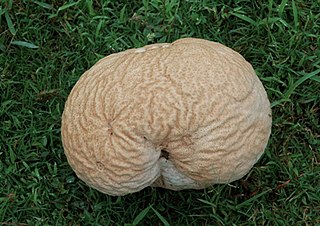
Calvatia is a genus of puffball mushrooms that includes the spectacular giant puffball C. gigantea. It was formerly classified within the now-obsolete order Lycoperdales, which, following a restructuring of fungal taxonomy brought about by molecular phylogeny, has been split; the puffballs, Calvatia spp. are now placed in the family Agaricaceae of the order Agaricales.

Hygrophoropsis aurantiaca, commonly known as the false chanterelle, is a species of fungus in the family Hygrophoropsidaceae. It is found across several continents, growing in woodland and heathland, and sometimes on woodchips used in gardening and landscaping. Fruit bodies (mushrooms) are yellow–orange, with a funnel-shaped cap up to 8 cm across that has a felt-like surface. The thin, often forked gills on the underside of the cap run partway down the length of the otherwise smooth stipe. Reports on the mushroom's edibility vary – it is considered poisonous, but has historically been eaten in parts of Europe and the Americas.

Jean Paul Vuillemin was a French mycologist born in Docelles.
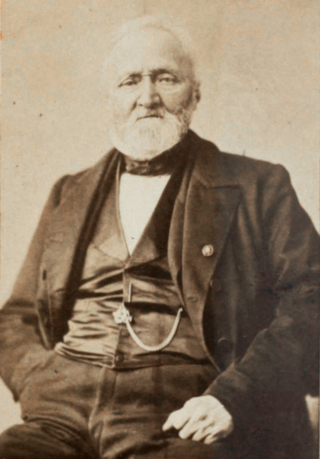
Jean Pierre François Camille Montagne was a French military physician and botanist who specialized in the fields of bryology and mycology. He was born in the commune of Vaudoy in the department of Seine-et-Marne.
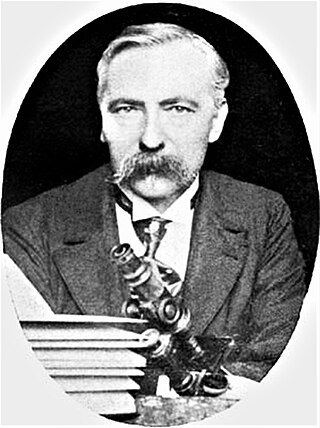
Narcisse Théophile Patouillard was a French pharmacist and mycologist.

The Phanerochaetaceae are a family of mostly crust fungi in the order Polyporales.

Cymatoderma is a widely distributed genus of poroid fungi in the family Meruliaceae.

Abrothallus is a genus of lichenicolous fungi. It is the only genus in the monotypic family Abrothallaceae, which itself is the sole taxon in the order Abrothallales.

Arachnion is a genus of gasteroid fungi in the family Agaricaceae.
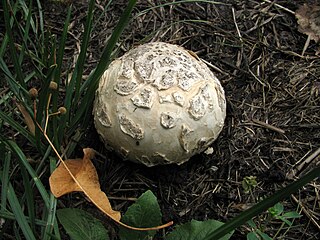
Mycenastrum is a fungal genus in the family Agaricaceae. The genus is monotypic, containing one widely distributed species, Mycenastrum corium, known by various common names: the giant pasture puffball, leathery puffball, or tough puffball. The roughly spherical to turnip-shaped puffball-like fruit bodies grow to a diameter of 6–24 cm (2–9 in). Initially covered by a thick, felted, whitish layer, the puffballs develop a characteristic checkered skin (peridium) in age. When the internal spore mass, the gleba, is firm and white, the puffball is edible, although some individuals may suffer mild gastrointestinal symptoms after eating it. As the spores mature, the gleba turns first yellowish then purplish brown. Spores are released when the peridium eventually splits open into irregularly shaped sections. Microscopically, the gleba consists of spherical, dark brown spores with rounded bumps on their surfaces, and a capillitium—intricately branched fibers that form long thorn-like spines. The puffball grows on or in the ground in prairie or desert habitats. Although widely distributed, it is not commonly encountered. Mycenastrum corium is a threatened species in Europe.

Podoserpula is a genus of fungi in the family Amylocorticiaceae. The genus contains six species including the type species, P. pusio, commonly known as the pagoda fungus. Species of the genus Podoserpula produce fruit bodies consisting of up to a dozen caps arranged in overlapping shelves, attached to a central axis. Its unique shape is not known to exist in any other fungi. The genus is known to occur in Australia and New Zealand, Venezuela, Madagascar, and New Caledonia.

Leucocoprinus fragilissimus, commonly known as the fragile dapperling, is a species of gilled mushroom in the family Agaricaceae.
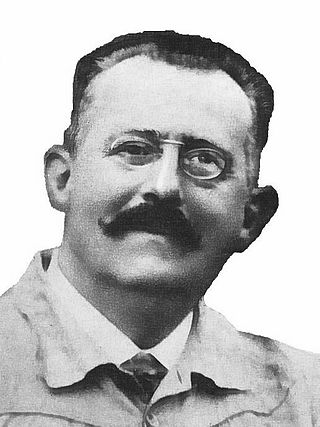
Paul Auguste Hariot, the son of Louis Hariot, was a French pharmacist and noted phycologist, best known for his 1900 publication Atlas Colorié des Plantes Médicinales Indigènes.

Lenzites warnieri is a species of fungus in the family Polyporaceae found in parts of Europe, Asia, and northern Africa. The species is a white rot pathogen on living wood. Its corky fruiting bodies in the shape of semicircular plates form on the trunks of several types of deciduous trees growing near water bodies in regions of moist sub-Mediterranean climate. The fruiting body, which has a lamellar fruit layer, produces spores only once.

Colus hirudinosus is a species of stinkhorn fungus (Gasteromycete) found in Asia, Australia, northern Africa, and southern Europe. The fruit body has a short, thick stalk that divides into several spongy, wrinkled, stalk-like, orange to red columns that are united at the top, thus forming a lattice. The spores are found within the gleba—a dark, olive-brown slime that coats the inside of the columns. Spores are spread by insects that are attracted by the fetid smell of the gleba, eat the spores, and pass them on to germinate elsewhere.
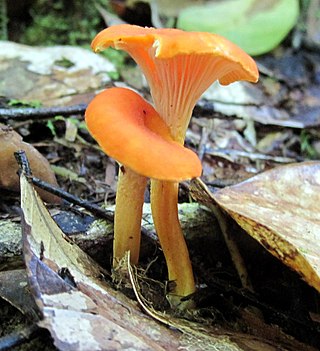
Cantharellus guyanensis is a tropical South American species of mushroom-forming fungus in the chanterelle genus (Cantharellus), first described by Camille Montagne from French Guiana in 1854.

Abrothallus welwitschii is a species of lichenicolous fungus in the family Abrothallaceae. It grows on species of the foliose lichen genus Sticta. The type specimen was originally collected in Portugal in 1840 by Austrian botanist Friedrich Welwitsch, and it is after him for whom the species is named. Camille Montagne described the species in 1851, but he did not published the name validly; it was published validly by Charles Tulasne a year later.

















